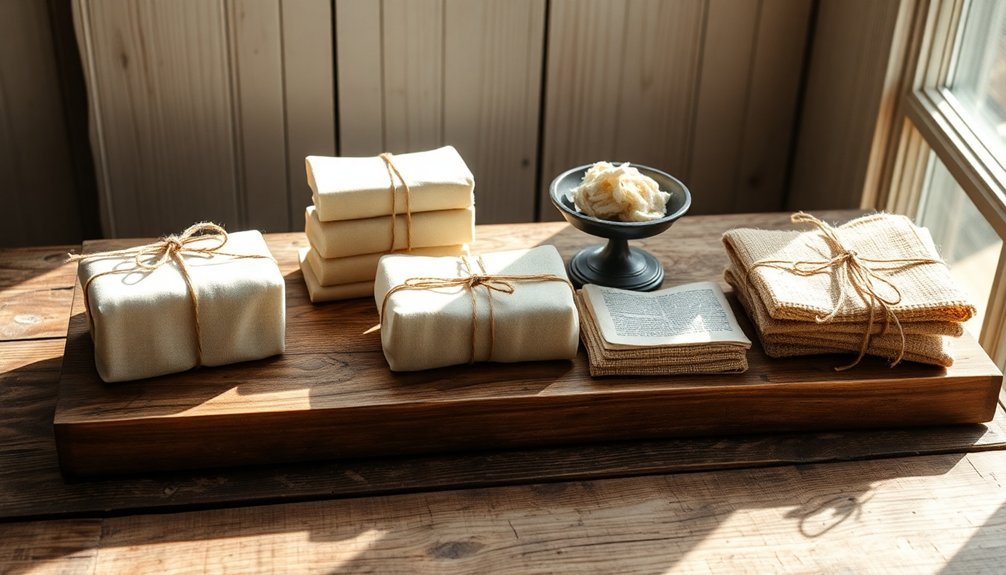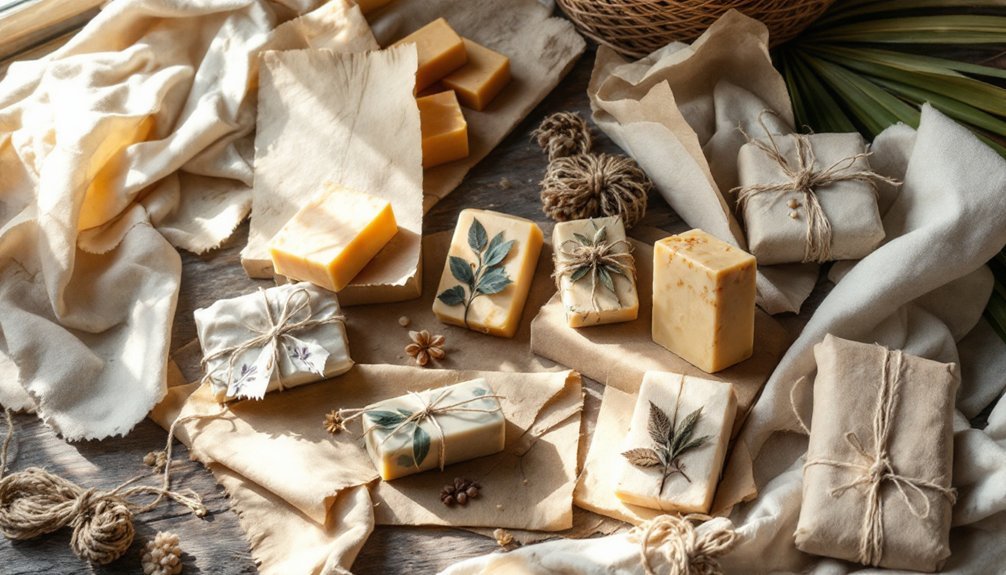The three best historical soap wrapping materials from the 1800s were natural fibers (cotton, linen, hemp), paper-based packaging, and wax-coated materials. You'll find muslin was particularly popular for its breathability, while decorative Victorian paper allowed for elaborate branding. Wax-coated papers provided essential moisture resistance for commercial production. These historical methods not only protected soap effectively but also showcased craftsmanship that continues to influence today's artisanal soap packaging techniques.
Natural Fiber Wrappings From the 1800S

While synthetic materials dominate today's packaging, the 1800s saw widespread use of natural fibers for soap wrapping that were both practical and environmentally sound. You'd find cotton, linen, and hemp commonly protecting soaps – all biodegradable options that served functional purposes while minimizing environmental impact.
Muslin, a lightweight cotton fabric, was particularly favored for its breathability, effectively shielding soaps from light and moisture damage.
For more rustic presentations, soap makers turned to durable jute and sisal fibers, which added distinctive aesthetic appeal to artisanal products.
As the century progressed, sustainable paper made from plant fibers emerged as a versatile alternative.
These wrapping choices reflected not just practicality but aligned with the era's growing commitment to environmental sustainability and craftsmanship – values we're now rediscovering today.
Paper-Based Packaging of the Victorian Era
As papermaking technology advanced greatly in the Victorian Era, soap manufacturers embraced paper-based packaging with unprecedented enthusiasm.
You'll find that decorative tissue papers and printed wrappers became the standard for soap products, reflecting the period's appreciation for beauty and craftsmanship.
Embossed and patterned papers served dual purposes—protecting the soap while greatly enhancing branding and marketing efforts.
Manufacturers recognized that attractive packaging influenced purchasing decisions in the growing consumer market. They invested in colorful lithographed labels that effectively showcased product ingredients and benefits.
If you're seeking authentic Victorian-style soap wrapping, look for rich designs featuring elaborate patterns and vibrant colors.
The era's paper-based packaging wasn't merely functional—it represented a transformative approach to product presentation that continues to inspire artisanal soap makers today.
Wax-Coated Materials in Early Commercial Soap Production

Wax-coated materials represented a major leap forward in soap packaging during the early commercial production era.
If you'd examined soap bars from this period, you'd notice how manufacturers cleverly used wax to provide essential moisture resistance, preserving the product's integrity during storage and transportation.
Before modern packaging technologies, these wax applications created an effective barrier against humidity and contaminants, greatly extending soap's shelf life.
In the 19th century, wax-coated paper became the industry standard, enhancing both durability and aesthetic appeal.
What made these packaging practices particularly innovative was how manufacturers combined functionality with branding—decorative elements, labels, and stamps on wax paper communicated brand identity to consumers.
This advancement in wrapping techniques contributed significantly to the growth and commercialization of the soap industry during that transformative era.
Frequently Asked Questions
What Is the Best Material to Wrap Soap In?
For wrapping soap, you'll find breathable options like cotton, paper, or kraft paper work best. They'll protect your soap while allowing moisture to escape. Cellophane offers visibility if you'd like to showcase your soap's appearance.
What Paper Is Best for Wrapping Soap?
Kraft paper is your best choice for wrapping soap. It's moisture-resistant and eco-friendly. You'll also find recycled paper, tissue paper, and paper bands work well for different aesthetic and functional needs.
What Was Used for Soap in the 1800S?
In the 1800s, you'd find people using animal fats, plant oils, and lye to make soap. They'd craft it at home, using tallow, olive oil, or coconut oil for different cleaning purposes.
What Material Is Used for Soap Packaging?
You'll find soap packaged in various materials including paper, cardboard, plastic, cellophane, cloth, and kraft paper. Modern packaging often balances protection, sustainability, branding needs, and consumer preferences for eco-friendly options.
In Summary
You've discovered how natural fibers, Victorian paper packaging, and wax-coated materials revolutionized soap presentation throughout history. These traditional wrapping methods weren't just practical—they reflected the craftsmanship and values of their eras. Whether you're a soapmaker or history enthusiast, incorporating these historical materials into your soap packaging will connect your products to a rich tradition of artisanal care and attention to detail.





Leave a Reply